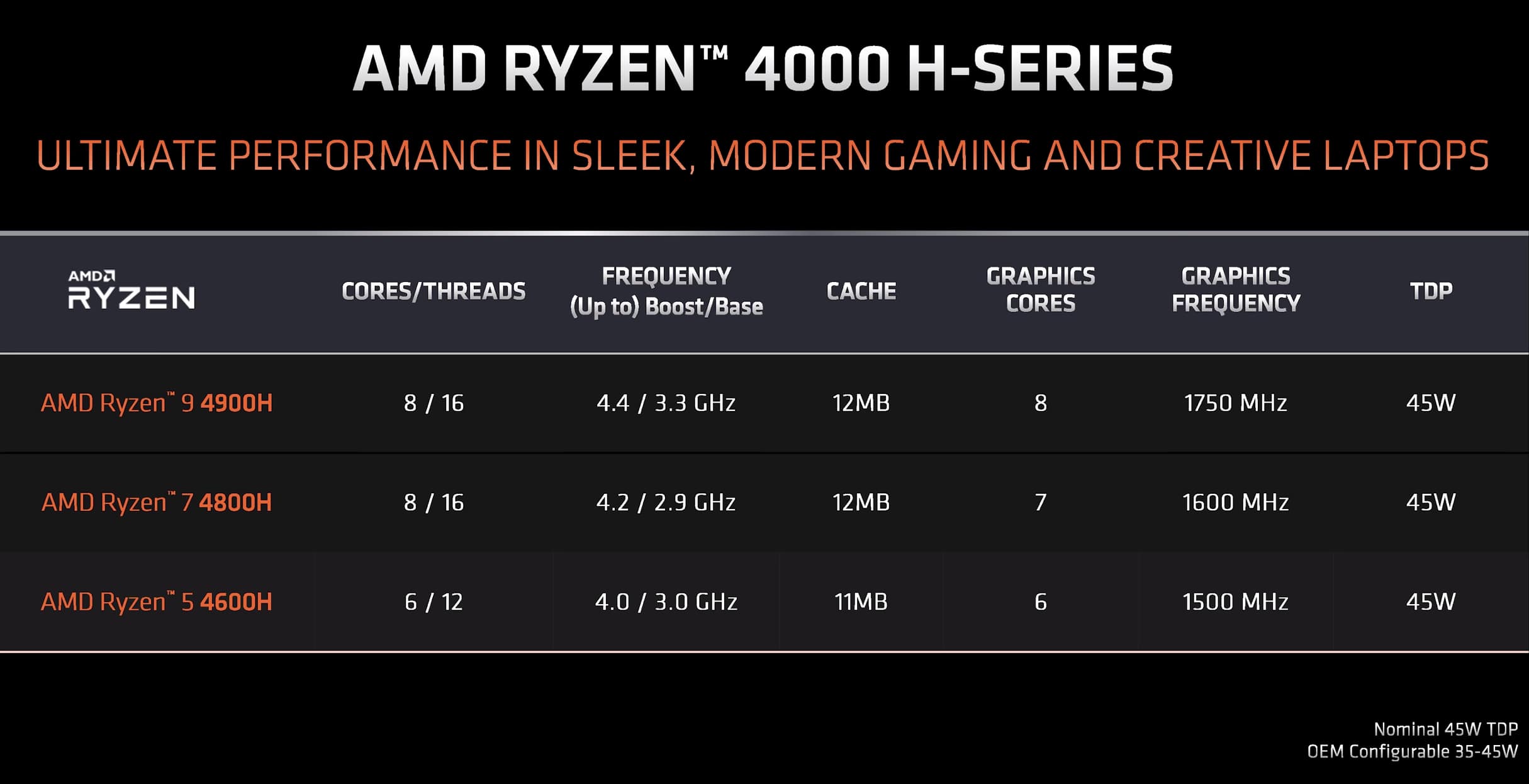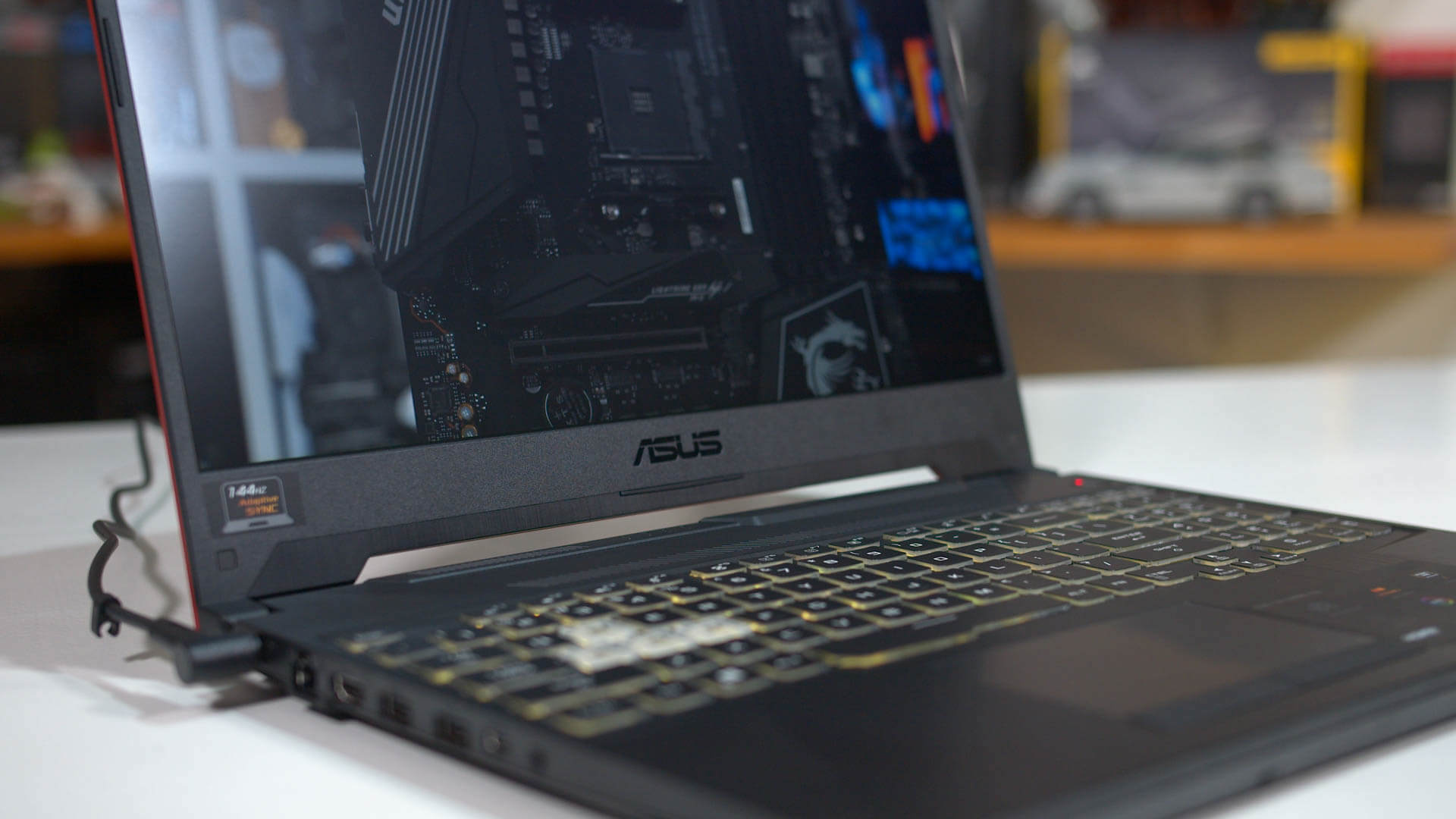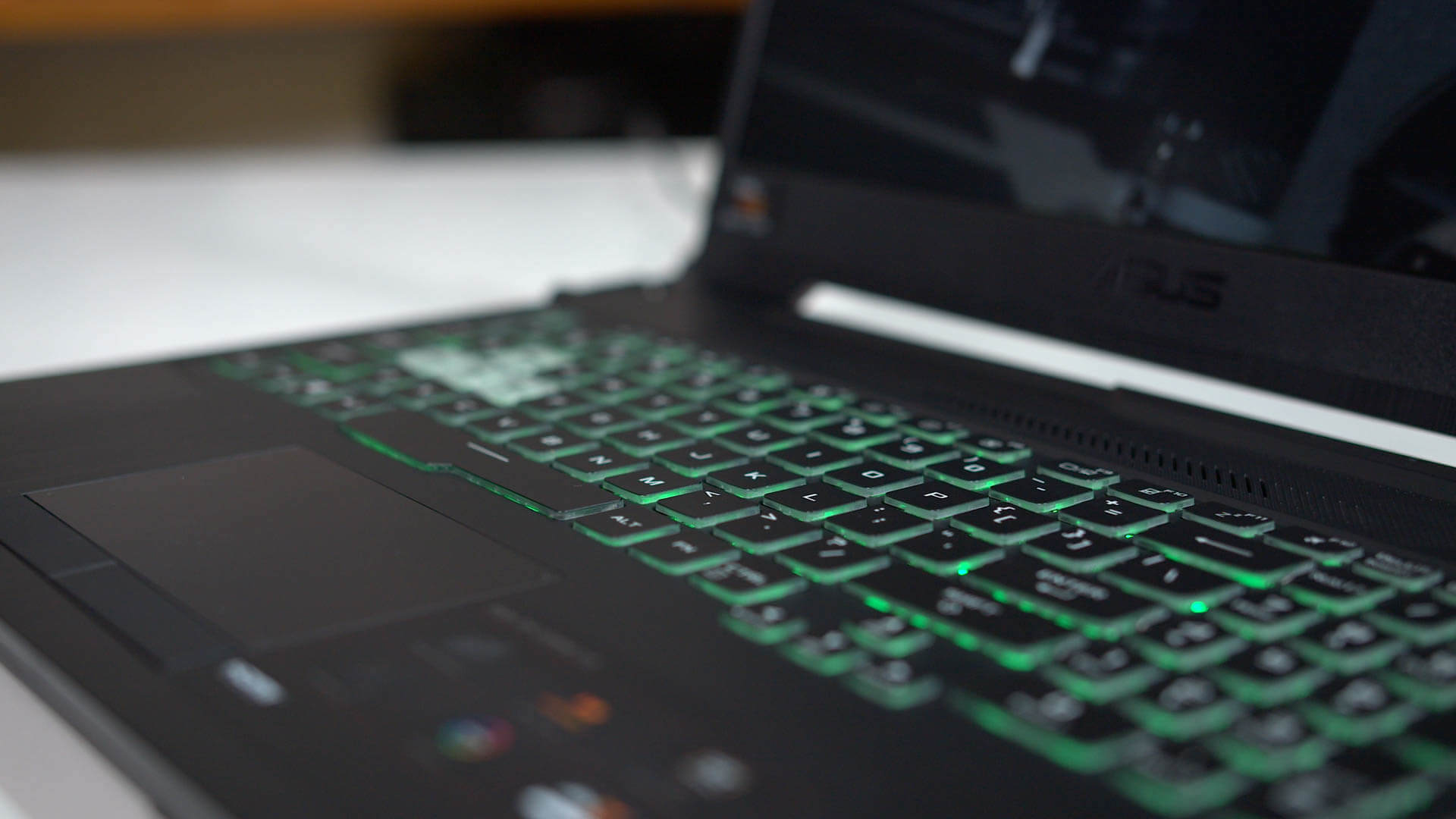The Ryzen 5 4600H is AMD's new mainstream processor in their H-series, designed for high performance productivity and gaming notebooks. There's no Ryzen 3 option in the series, so the Ryzen 5 4600H is actually the lowest tier APU offered here.
This is the chip AMD is selling for entry-level systems, and yet it's a compelling piece of silicon to be putting in budget devices: you get 6 Zen 2 CPU cores and 12 threads, a base frequency of 3.0 GHz with boost up to 4.0 GHz, along with 8MB of L3 cache and a standard 45W TDP.
With AMD offering 8 cores in more expensive parts like the Ryzen 7 4800H (see the review), they can comfortably include six cores in mainstream laptops while maintaining nice product segmentation.
You also receive all the benefits of AMD's 7nm Zen 2 architecture, so that means a significant boost to efficiency over previous-gen parts, improved IPC and a refreshed GPU design. The Ryzen 5 4600H features an integrated Vega GPU with 6 compute units clocked up to 1,500 MHz, but in practice the vast majority of systems using this APU will also feature a discrete GPU.
Direct competition comes from Intel's latest 10th generation, as well as older parts that are still being offered. Intel offers Core i5 options for the entry-level market, however these are just quad-core designs with average clock speeds. The Core i5-10300H for example, clocks up to 4.5 GHz and packs 8MB of L3 cache within its 45W TDP.
This newer 10th-gen part isn't too different from the quad-cores that came before it. We get a small clock speed gain over the Core i5-9300H, which itself is a small clock speed gain on the Core i5-8300H. If we trace it back a few more generations, you'll find a similar design used for 2015's Core i7-6700HQ. With Intel stuck on 14nm this whole time, AMD is taking the opportunity to jump in and shake up the laptop market.
The laptop used for today's testing is the Asus TUF Gaming A15 that includes the Ryzen 5 4600H coupled with a GTX 1650 Ti GPU. This is a new entry-level GPU that unfortunately we don't have a ton of comparison data to use against right now for GPU-heavy benchmarks, but we'll work through that over time.
This laptop looks very similar to the TUF Gaming A15 that we used in our Ryzen 7 4800H review, however there are some subtle differences to the design both inside and out. Cooling components is a smaller unit that lacks an exhaust vent along the right side. The GPU is a lower power variant as well when compared to Ryzen 7 models. Asus also ships this laptop with 8GB of single-channel memory, leaving a free DIMM slot for future upgrades. However, this cripples out of the box performance considerably.
In other words, out of the box, this laptop is your average affordable entry, but to ensure an apples-to-apples comparison with other systems, we swapped out the memory for a full 16GB of dual-channel DDR4-3200. Lots of entry-level systems use just a single DIMM which is a bit frustrating, but a standard cost saving method nonetheless.
As usual when we run laptop benchmarks, the numbers you will see from other system specs are an average of results across several laptops with the same hardware configuration. We try and test apples-to-apples as much as possible while also removing bottlenecks, and all configurations are tested with default power settings unless otherwise specified. For both AMD and Intel CPUs that normally means a 45W long-term power limit.
Benchmarks
Let's kick this one off with a look at Cinebench R20 and... wait that can't be right. The Ryzen 5 4600H is up near the top of the charts, not at the bottom like you'd expect from an entry-level APU. With a score over 3200 points, AMD's mainstream APU is outperforming much higher-tier processors from Intel like the Core i7-10875H and Core i9-9880H in the multi-core test. This is impressive considering AMD's part packs just 6 cores, while Intel are offering 8. The superior efficiency of Zen 2 allows AMD to take a win here by a double-digit margin over the 10875H, while featuring a core disadvantage.

The situation is even more impressive when pitting the 4600H up against the new Core i7-10750H in a core-for-core battle. AMD's part is 27% faster in terms of multi-threaded performance and equal for single-thread, which is pretty great given these chips don't really compete with one another from a price perspective.
It's not as good as Ryzen Mobile can get in terms of efficiency, the Ryzen 7 4800H is another 30 percent faster with the same power usage, the usual situation of clocking more cores at a lower frequency plays out nicely for Zen 2 as it does with Intel's CPUs.
The big kicker comes when we actually put the Ryzen 5 4600H against the chip it's competing with, the Core i5-9300H. Now I haven't tested the new Core i5-10300H yet, but on paper it should be very similar to the 9300H, maybe slightly faster. And in Cinebench R20, the Ryzen 5 4600H absolutely obliterates the 9300H. It's twice as fast for multi-thread and around 8 percent faster in single-thread.

We see similar outstanding results when looking at Cinebench R15, with nearly 2x the performance of the Core i5-9300H as we just were talking about. Margins against Intel's other processors hold on as well, with a 29% lead over the Core i7-10750H and a 21% lead over Intel's older Core i7-9750H.

AMD isn't messing around with video encoding performance either. In Handbrake, the Ryzen 5 4600H delivers a crushing blow to the Core i5-9300H, coming in 65 percent faster. To put this margin in perspective, what the Core i5-9300H could encode in 68 minutes, the Ryzen 5 4600H does in just 41 minutes.
This puts the 4600H next to Intel's Core i7-10875H in terms of Handbrake performance, which is very impressive given the enormous price discrepancy between 4600H laptops and 10875H laptops.

AMD continues to produce massive numbers in anything multi-threaded as was the case in Blender. The 4600H is over twice as fast as Intel's Core i5-9300H, and more than 30% faster than Intel's current six-core offering.

Ryzen also performs well for code compilation. For GCC compiling, the Ryzen 5 4600H is more than 50% faster than the Core i5-9300H, while commanding substantial leads over Intel's six-core products. This GCC compilation has multi and single threaded components but unless we're fully single threaded, AMD appears to hold a double digit performance gain.

The Ryzen 5 4600H also performs well for Chromium compilation using Google's recommended settings. It is ~57% faster than Intel's quad-core competitor, though the margins are a bit slimmer against six-core parts. The Ryzen 5 4600H is still 8% faster than the Core i7-10750H and around 20% faster than the Core i7-9750H.

Moving into shorter term workloads, Microsoft Excel gets our first good look at how AMD fares against Intel with the same L3 cache size. Both the Ryzen 5 4600H and Core i5-9300H have 8MB of L3 cache, and we see AMD providing similar margins to other tests with a 45% performance advantage. However as soon as you jump up to an Intel CPU with 16MB of cache, this heavy Excel workload swings back in favor of Intel even if by a slim margin. AMD is almost able to offset the cache disadvantage with higher CPU core efficiency.

While this is representative of heavy Excel performance, in lighter productivity workloads as seen in PCMark's Productivity test, AMD holds a lead thanks to higher single-thread performance. We're seeing a 10% margin over the Core i5-9300H, along with around a 7% lead on the Core i7-10750H and 9750H.

Then for general PC usage for things like web browsing and app loading, AMD also holds a small margin here with their six-core H-series processor. At worst we're getting equivalent performance to a Core i7-10750H, which is a pretty great place to be in.

7-Zip is another workload that typically plays nice with AMD CPUs. The Ryzen 5 4600H is substantially faster than the Core i5-9300H in this test, and we do see around a 20 to 25 percent lead over Intel's six-core CPUs in decompression as well. Compression is another story, AMD easily beats the Core i5. but can't keep up to those Core i7 offerings.

MATLAB R2020a is a widely used tool by engineers. Not only is the Ryzen 5 4600H a decent 28% faster than Intel's quad-core, it's also 7% faster than the Core i7-10750H.

The weakest result for Ryzen is with Adobe Acrobat PDF exporting. In this single-thread test, the 4600H is marginally slower than the Core i5-9300H and that margin grows with Intel's higher-clocked parts like the Core i7-10750H.

AMD remains the faster CPU option for AES cryptography. This is a hardware accelerated function on modern processors and it appears AMD has the better engine for this, pulling 30 percent ahead of Intel's competing laptop processors.
The following benchmarks are all compute workloads, so this means they include some form of GPU usage along with CPU usage. Given the system we have features a GeForce GTX 1650 Ti, we don't have any solid comparison data for this test run, but we figured we'd include them anyway just for reference. This will let you gauge how this sort of system will compare to some of the more expensive laptop options available in the market.

Adobe Photoshop is not a very GPU heavy application and is mostly dominated by CPU performance. The Ryzen 5 4600H performs well, matching the performance of the Core i7-9750H despite featuring a slower GPU. This configuration easily outperforms the Core i5-9300H when paired with a GTX 1660 TI as well, which bodes well for creators that do a lot of Photoshop on their laptop.

Next up we have Adobe Premiere. We're currently using the 14.2.0 Beta for testing, as it introduces hardware acceleration for Nvidia and AMD GPUs, and should be representative of performance moving forward. In Puget's Export test, again the Ryzen 5 4600H performs well considering it has a slower GPU.

And if you want to use a software encode, for example a 2 pass encode, the Ryzen 5 system punches well above its weight, slotting in between Core i7-10875H and Core i7-10750H systems despite featuring just an entry-level GPU for effect acceleration.


The editing experience on Ryzen is solid, performing well in Puget's Live Playback workload, matching Core i7 processors. And then for effects like Warp Stabilizer, Ryzen APUs as a whole sit a class above Intel offerings.
Our last productivity workload is DaVinci Resolve Studio and this is one where the GPU plays a significant role in encoding performance. Given the GTX 1650 Ti isn't the most powerful GPU going around, it falls towards the bottom of the charts. It should be interesting to see how the 4600H fares when paired with something more powerful, like a GTX 1660 Ti or RTX 2060. For now this is the only laptop we could find using the 4600H.

We also wanted to show at least some form of gaming benchmark but the GTX 1650 Ti is easily outclassed by other GPUs in our database. Even in a game like CS:GO at low settings, the benchmark pass had some sections that were GPU limited with this 50W discrete card. So for gaming performance we'll just have to wait for a proper comparison to come along because this GPU-limited environment isn't suitable. For gaming purposes, we'd expect most GTX 1650 Ti systems to perform similarly due to the GPU bottleneck; the CPU isn't much of a consideration.
Performance Breakdown
Let's blast through some performance comparisons before wrapping this up. The Ryzen 5 4600H is significantly faster than the Core i5-9300H in most workloads, which we suspect will also be the case with the Core i5-10300. Multi-thread performance is up to twice as fast with the core count and efficiency advantage that AMD holds, but even with single-thread performance we saw better performance in most instances. For frequent use cases like decompression, cryptography, app loading, web browsing and light productivity, the 4600H was the faster CPU.

The Ryzen 5 4600H is also generally faster than the Core i7-10750H, a higher tier CPU from Intel that features the same six-core layout. In multi-thread workloads, the 4600H was 20 to 30 percent faster, and also fared better in some lighter thread count tests. However, with the 10750H clocking into the high 4 GHz range for burst applications, as well as having great single-thread performance and higher cache, the Core i7 CPU can take the performance crown in a few tests.

Similar story with the Core i7-9750H, although in areas where the Intel part wins, the margins are closer than we just saw. We think it's safe to say that AMD is providing better performance with the same core count with this generation of laptop CPUs.


The Ryzen 5 4600H holds its own against the eight-core Core i7-10875H in multi-core tests. In fact, the Ryzen 5 4600H can be up to 10 percent faster. However with superior single-thread performance and higher clock speeds, there are also plenty of workloads where the Ryzen 5 4600H is not faster.

We've mentioned in the past how the Ryzen 7 3750H was not a very good laptop processor and this is shown quite clearly with the performance gains AMD were able to achieve moving to Zen 2. The Ryzen 5 4600H decimates AMD's flagship from the previous-gen, sometimes getting a 100% performance uplift which almost sounds ridiculous.

As for how the Ryzen 5 4600H stacks up to the Ryzen 7 4800H, it's no surprise to see the Ryzen 5 option falling behind. Generally speaking, the 4600H is ~20 percent slower for multi-thread tasks and 4 to 8 percentage slower for single-thread. What's impressive here is that in the same 45W power envelope with the same boost characteristics, AMD are able to add in 33% more cores for around a 30% performance increase going from 4600H to 4800H.
Higher core count parts are usually more efficient in mobile form factors as they sit in a more favorable position on the voltage frequency curve, but AMD is going above and beyond what is usually possible. This is probably a result of binning and simply using higher quality silicon for the 8-core chips. And while the 4600H is in a lower bin, it still delivers much better performance than other CPUs in its class.
Wrap Up
It's hard not to be impressed with what AMD is delivering this generation with Ryzen Mobile APUs. The Ryzen 7 4800H achieves a 30 to 40 percent multi-core performance lead over Intel's current high-end 8 core processors, and while that sets the right tone for Zen 2 on laptops, we think the Ryzen 5 4600H is the most impressive of the bunch.
This six-core CPU offers a performance advantage over Intel's Core i5 quad-cores that is simply unheard of in the mobile space. You don't see 2x performance leads within the same price class very often, let alone in power constrained laptop form factors.
Simply put, the Ryzen 5 4600H is punching well above its class, often matching or beating Intel's Core i7 processors, especially the Core i7-10750H.
Simply put, the Ryzen 5 4600H is punching well above its class, often matching or beating Intel's Core i7 processors, especially the Core i7-10750H. Intel may have been a bit blindsided by offering just a quad-core CPU in the Core i5-10300H. Granted, the Core i5 range isn't very popular with OEMs, but whether the Ryzen 5 4600H is competing against the Core i5 range or a Core i7, AMD is still coming out on top in most productivity workloads.
Finally, how well the Ryzen 5 4600H fares in practice is going to depend greatly on the system it's integrated into. In budget systems that use it, the CPU won't be a problem, but performance limitations might come from the memory or GPU configurations, as is the case with this Asus TUF system that we estimate will target the $900-950 price point.
The Ryzen 5 4600H is powerful enough that it throws up interesting questions around laptop configurations. Most of the time, OEMs will offer Core i7 upgrades at anything above base models because Intel's quad-core is not that great. But in an entry to mid-range system, is a Core i7 or even Ryzen 7 required? Could OEMs offer, say, a GTX 1660 Ti coupled with a Ryzen 5 4600H for less money than an equivalent laptop featuring a higher-tier CPU? That could end up being a fantastic balance in the budget space between price, CPU and GPU performance.








